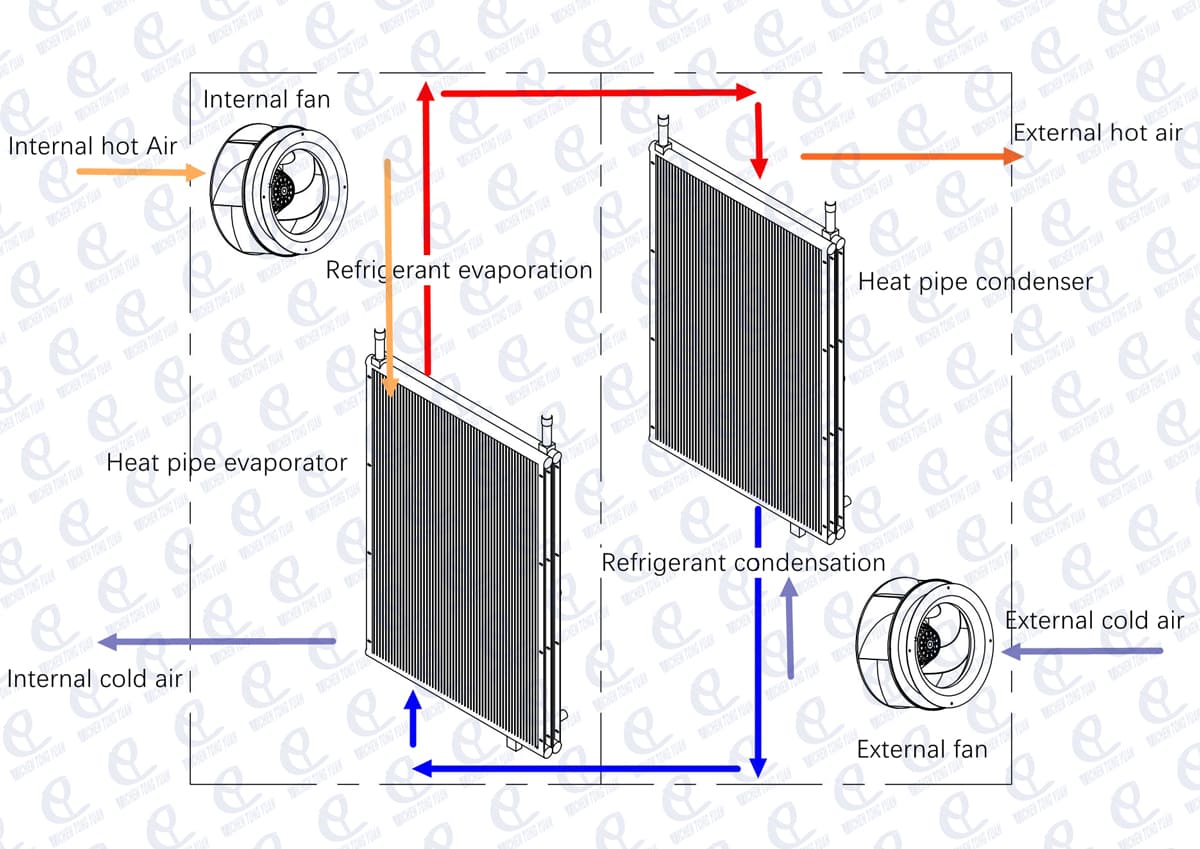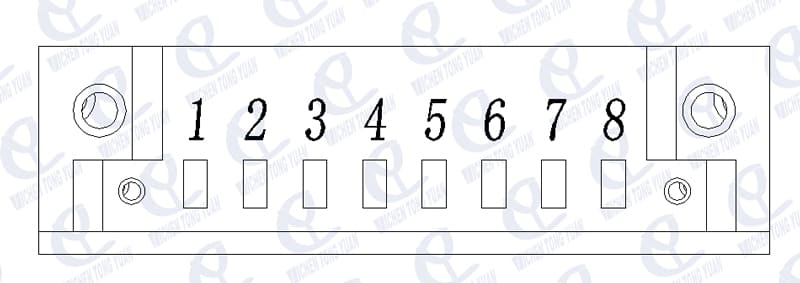Applications of Electrical Enclosure Heat Exchanger
Electrical Enclosure Heat Exchanger is essential for maintaining optimal temperature control across various industries. This heat exchanger is specifically designed to protect sensitive electronic components from overheating, ensuring the continuous and efficient operation of equipment in diverse environments. Below are key applications of Electrical Enclosure Heat Exchanger:
1. Industrial Automation
In industrial automation systems, Electrical Enclosure Heat Exchanger is critical for preventing the overheating of components like PLCs (Programmable Logic Controllers), drives, and sensors. These systems often operate in high-temperature environments, where excessive heat can disrupt operations or damage equipment. Electrical Enclosure Heat Exchanger ensures internal temperatures stay within safe limits, preventing failure and extending the life of automation equipment.
Key Benefits:
Prevents overheating of sensitive electronics.
Enhances system reliability by maintaining consistent temperatures.
Minimizes downtime, ensuring continuous operations.
2. Telecommunications
Telecom enclosures, which house network equipment like routers, servers, and switches, require temperature regulation to function efficiently. Electrical Enclosure Heat Exchanger helps maintain an ideal temperature inside these enclosures, protecting the sensitive equipment from overheating due to external temperature fluctuations.
Key Benefits:
Regulates internal temperatures to protect telecom equipment.
Ensures uninterrupted service by preventing equipment failure.
Improves energy efficiency by maintaining optimal operating conditions.
3. Renewable Energy Systems
In solar power plants, wind farms, and energy storage systems, Electrical Enclosure Heat Exchanger is used to maintain proper temperature inside enclosures that house inverters, batteries, and control systems. These components are sensitive to temperature fluctuations and can overheat in extreme conditions. Electrical Enclosure Heat Exchanger ensures that these systems operate safely and efficiently, regardless of external weather conditions.
Key Benefits:
Protects sensitive electronics from temperature extremes.
Improves energy efficiency by ensuring optimal performance.
Increases the lifespan of renewable energy equipment.
4. Data Centers
Data centers house thousands of servers and networking equipment, all of which generate significant heat. Electrical Enclosure Heat Exchanger in server enclosures is essential for preventing overheating and ensuring continuous, efficient operation. By controlling the temperature within these enclosures, heat exchangers help improve system performance and reduce the risk of equipment failure.
Key Benefits:
Prevents equipment damage from excessive heat.
Optimizes energy usage, reducing cooling costs.
Increases reliability of data center operations.
5. Transportation and Railways
Electrical Enclosure Heat Exchanger is used in electrical enclosures for rail signaling equipment, traffic control systems, and vehicle electronics to protect them from overheating in demanding environments. Whether in harsh weather conditions or high-heat environments, these heat exchangers ensure systems function smoothly without interruptions.
Key Benefits:
Maintains operational efficiency in harsh environments.
Protects critical transportation systems from thermal stress.
Improves safety by ensuring reliable operation.
6. Food and Beverage Industry
Automated machinery in food and beverage processing plants, such as packaging and processing equipment, can generate a lot of heat. Electrical Enclosure Heat Exchanger regulates the temperature inside enclosures, ensuring that electronic systems continue to function properly despite challenging conditions like high humidity or temperature fluctuations.
Key Benefits:
Prevents overheating of automated systems.
Ensures consistent operation despite fluctuating temperatures.
Maintains food safety and quality through reliable equipment.
7. Oil and Gas
The oil and gas industry operates in extreme environments, often involving offshore platforms or refineries. Electrical Enclosure Heat Exchanger is used to regulate the temperature of enclosures housing sensitive equipment like control and monitoring systems. These systems must be protected from both high temperatures and hazardous conditions.
Key Benefits:
Reduces risk of overheating in hazardous environments.
Ensures continuous operation in extreme conditions.
Protects against environmental factors like humidity and corrosive agents.
8. Power Generation
In power plants, including turbine control systems, switchgear, and other monitoring equipment, Electrical Enclosure Heat Exchanger helps prevent overheating of electrical enclosures. These systems are constantly running and need efficient thermal management to maintain reliable power generation.
Key Benefits:
Optimizes thermal regulation in power generation systems.
Increases system reliability, reducing the risk of failure.
Enhances energy efficiency by maintaining optimal operating conditions.
9. Healthcare and Medical Devices
In medical facilities, Electrical Enclosure Heat Exchanger is used to regulate temperatures in enclosures housing critical medical devices like diagnostic machines, laboratory equipment, and patient monitoring systems. These devices need to maintain precise operating temperatures to ensure accurate results and reliable performance.
Key Benefits:
Prevents overheating of sensitive medical equipment.
Ensures reliable operation of diagnostic and laboratory devices.
Improves accuracy in medical testing and procedures.
10. Water and Wastewater Treatment
In water treatment facilities and wastewater treatment plants, Electrical Enclosure Heat Exchanger regulates the temperature inside enclosures that house pumps, motors, and control systems. These plants often operate in high-moisture environments, where controlling temperature is critical to prevent damage to sensitive electronics.
Key Benefits:
Keeps essential treatment systems operational despite humidity.
Improves system longevity by preventing thermal damage.
Ensures continuous water treatment without equipment failures.
11. Outdoor Signage and Displays
Digital signage, LED displays, and interactive kiosks are exposed to varying weather conditions, and their internal electronics can overheat. Electrical Enclosure Heat Exchanger helps prevent overheating by ensuring that the internal temperature of the enclosures stays within optimal ranges, even in extreme outdoor environments.
Key Benefits:
Prevents damage to electronics from high temperatures.
Ensures reliable performance of outdoor displays.
Improves longevity of digital signage equipment.
12. Aerospace and Defense
Electrical Enclosure Heat Exchanger is used in aerospace and military applications to protect sensitive electronics housed in enclosures, such as avionics, radar systems, and communication devices. These systems are exposed to extreme conditions, including high altitudes and rapid temperature changes, where thermal management is essential.
Key Benefits:
Protects critical systems in challenging environments.
Maintains performance of aerospace and defense electronics.
Ensures system reliability during high-stress operations.
13. Manufacturing and Processing Plants
Manufacturing plants, especially those involving heavy machinery like CNC machines or robotics systems, generate a lot of heat. Electrical enclosures housing control systems for these machines use Electrical Enclosure Heat Exchanger to regulate temperature, ensuring the equipment operates smoothly and reliably.
Key Benefits:
Prevents overheating in automated manufacturing equipment.
Improves operational continuity in high-heat environments.
Reduces risk of failure, extending the life of machinery.
14. Chemical Processing
In chemical processing plants, enclosures protect control and monitoring systems from harsh conditions, including extreme temperatures and corrosive chemicals. Electrical Enclosure Heat Exchanger in these enclosures helps to maintain temperature stability, preventing damage to sensitive equipment.
Key Benefits:
Prevents thermal damage in extreme chemical environments.
Ensures safe operation of sensitive control systems.
Enhances equipment durability in harsh conditions.
15. Marine Applications
Marine environments, such as ships and offshore platforms, expose electrical enclosures to saltwater and high humidity. Electrical Enclosure Heat Exchanger is used to regulate the temperature of sensitive equipment, ensuring it continues to operate efficiently despite these challenging conditions.
Key Benefits:
Prevents corrosion caused by saltwater exposure.
Ensures system reliability in offshore environments.
Keeps critical electronics operational in harsh conditions.
Conclusion
Electrical Enclosure Heat Exchanger plays a crucial role in protecting sensitive electrical equipment across various industries. By regulating internal temperatures, it helps maintain the efficiency, reliability, and lifespan of critical systems in diverse environments. From industrial automation to marine applications, the benefits of using Electrical Enclosure Heat Exchanger in electrical enclosures are significant, ensuring smooth and uninterrupted operations even in extreme conditions.
































